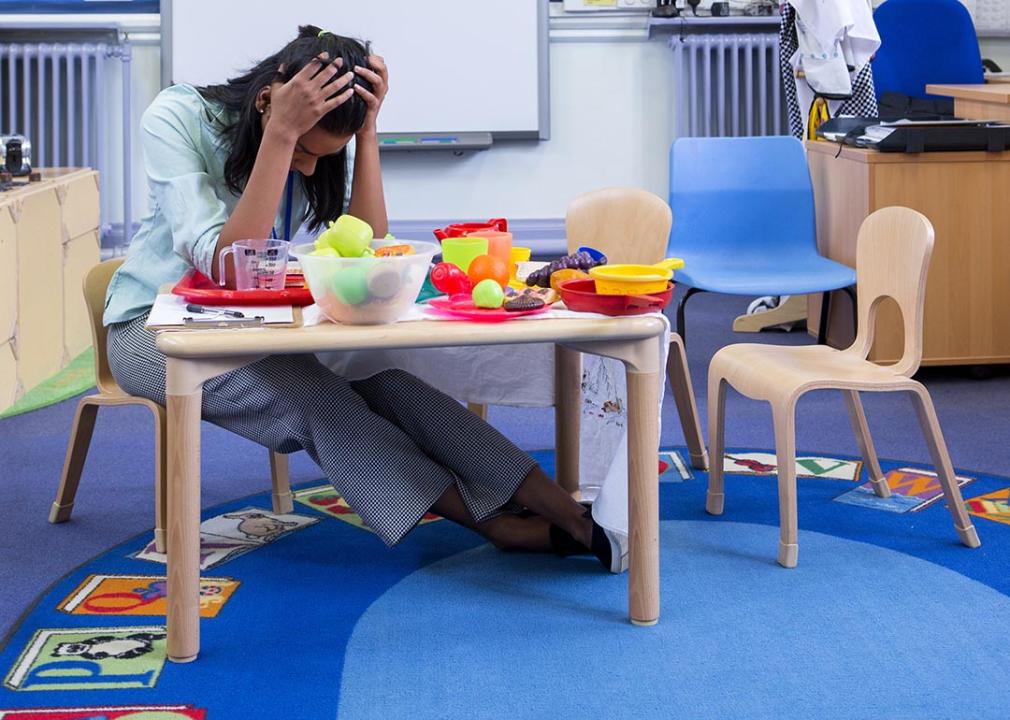Teacher QuitToks and what they say about the future of teaching

DGLimages // Shutterstock
Teacher QuitToks and what they say about the future of teaching
Teachers sitting in a young student classroom with head in her hands.
As the summer break nears its end, many teachers are starting to plan for the school year ahead. Some plan not to return. The trend of teachers quitting has been noticeable on social media. Teachercertification.com reports that teachers are among the largest groups posting QuitToks, with over 72 million videos under the theme Teacher QuitTok. The videos often point out issues causing burnout for teachers.
This loud quitting could impact the minds of those planning their future careers, which is a concern since fewer people are already choosing careers in education.
TeacherCertification.com spoke with a teacher who recently shared their resignation on social media to discuss the reasons behind their public resignations and what it means for the future of teaching.
What Are Teacher QuitToks?
The social media phenomenon called QuitTok gained popularity in 2023 with many influencers posting videos of themselves “loud quitting”— or publicly sharing their resignation stories on social media platforms like TikTok and Instagram. As of June 2024, there are 134M posts in TikTok with #quittok.
Teachers also use the hashtags #TeacherQuitTok, #TeacherBurnout, and #ExTeacher, further demonstrating their perspectives.
In Teacher QuitToks, former teachers often reflect on their decision to quit and bring transparency to their experiences by highlighting systemic issues within the education sector. The trend has gained traction — some videos receive millions of views and spark widespread discussions about workplace conditions and the challenges faced by educators.
The Reasons Behind Teacher QuitToks
Teacher QuitToks often cite various frustrations and systemic issues as their reasons for leaving. Common themes include a lack of support from the administration, overwhelming workloads, insufficient pay, and the emotional toll of teaching under challenging conditions.
Trevor Boffone, who shared his resignation on TikTok, explained, “Because my identity on those platforms was so tied to being a high school teacher, I felt like I needed to put out a public statement letting people know not only that I had resigned, but also giving more information about the decision. Mostly I was trying to avoid tons of comments and questions when I all-of-a-sudden stopped talking about being a high school teacher and no longer posted videos from my classroom.”
Many of the public resignations serve as a form of protest and a call for change within the education system. By sharing their stories, teachers hope to raise awareness about the realities of the profession and inspire reforms that address the underlying problems.
Impact on the Teaching Profession
The growing trend of QuitToks could have significant implications for the teaching profession. On one hand, it brings much-needed attention to the issues that teachers face and drives conversations and actions toward positive change. On the other hand, the visibility of these resignation stories could further discourage individuals from pursuing careers in education and worsen the existing teacher shortage.
Boffone highlighted the changing student behavior post-COVID-19 as a significant challenge, “The students changed dramatically from February 2020 to May 2023. I never really had behavior issues or disrespectful students pre-COVID. Suddenly, those things did not work anymore. Moreover, student apathy skyrocketed, and the job became so demoralizing.”
He also described the breaking point that led him to quit teaching. “I loved teaching high school and honestly wanted to continue to do it for many years. My main issue is that I felt like I had no personal time. I was always at school and that quickly led to burn-out. My principal was unwilling to make me part-time and to even be creative about finding a way to make the job more sustainable for me. Once my principal told me I had to be full-time, I immediately resigned,” he said.
What Support Teachers Need to Stay in the Profession
Despite the challenges he faced, Boffone believes that, with the right support, many teachers would choose to stay in the profession. He emphasized the need for flexible working conditions and better funding, “I would love for schools to explore flexible working conditions for teachers. The school day is too long, and classes are filled to capacity. I think finding pathways for part-time teachers could be a game-changer. We also have to fight for school funding to hire more teachers and reduce class sizes. Teaching 40 students in a high school class is unrealistic and unsustainable.”
Boffone still encourages people to pursue careers in education, “If someone has the passion and vocation for teaching then they should absolutely pursue it. I still think there are many positives to the job and much of this will depend on the school and the school district. It also doesn’t have to be a forever career. It’s okay to only teach for a few years. It’s okay to leave teaching. It’s okay to put yourself first and find a career that is sustainable for you.”
By listening to the voices of those who have left and those still within the system, stakeholders can work toward creating a more supportive and rewarding environment for educators. The future of education may depend on it.
![]()
This story was produced by Teachercertification.com and reviewed and distributed by Stacker Media.